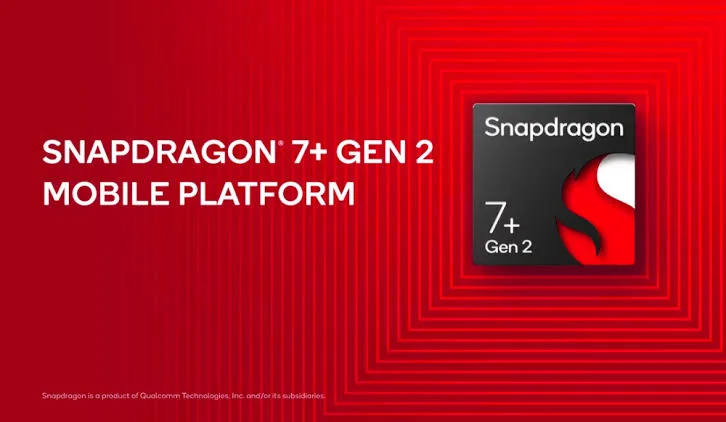Snapdragon 7+ Gen 2: The Ultimate Midrange SoC
The Snapdragon 7+ Gen 2 is set to take the world by storm. It is currently one of the best SoCs in the world but is it worth the hype? Let's find out.
The Qualcomm Snapdragon 7+ Gen 2 is a “new” System-on-Chip (SoC) by the renowned chip manufacturer, Qualcomm. This midrange SoC has garnered significant attention for all the right reasons. Positioned as the successor to the somewhat underwhelming Snapdragon 7 Gen 1, this SoC comes with even grander ambitions.
The Snapdragon 7+ Gen 2 was announced in March of 2023 and has already marked its presence in several smartphones, with the Poco F5 being a prominent example.
Key Specifications of the Snapdragon 7+ Gen 2
- CPU cores: 1x ARM Cortex X2 (2.9GHz) + 3x ARM Cortex A710 (2.49GHz) + 4x ARM Cortex A510 (1.8GHz)
- GPU: Adreno 725
- ISA: ARMv9
- Fab: 4nm TSMC
- RAM: LPDDR5 (16GB)
- Storage: UFS 3.1
- ISP: Spectra
- AI/ML: Hexagon
- Camera support: 200MP
- Video support: 4K @60fps
- Connectivity: 4G, 5G, Bluetooth 5.3, Wi-Fi 6, USB, GPS
(Click here to see more specs)
Performance of the Snapdragon 7+ Gen 2
The Snapdragon 7+ Gen 2 immediately throws away all of its midrange pretense as soon as you take a look at the specs. It has a flagship-grade 1+3+4 DynamIQ setup of 1 ARM Cortex X2 + 3 ARM Cortex A710 + 4 ARM Cortex A510. For graphics and gaming, there is an Adreno 725 GPU.
Upon my initial encounter with these specifications, a sense of déjà vu washed over me, as if I had encountered them previously. This familiarity is attributed to the fact that the 7+ Gen 2 is essentially a refined iteration of the Snapdragon 8 Gen 1. For those not in the know, the 8 Gen 1 served as the flagship in the year 2022. Consequently, the Snapdragon 7+ Gen 2 seamlessly fulfills every expectation of an SoC's capabilities. Its performance is truly exceptional.
The single Cortex X2 CPU core and the three additional Cortex A710 can tackle any task thrown at them. When you throw in the Adreno 725 GPU, you get a very powerful combo. There is no task made for Android that it cannot tackle. Is it a 4K video capture and editing? Easy. Is it HD gaming on ultra-high FPS settings? Bring it on! When it comes to performance, this SoC is amongst the world’s top 10 in flagship territory. This SoC could easily power a mini laptop/PC with little fuss.
However, with great processing power comes great battery drain, thus the remaining 4 Cortex A510 take over and do the light tasks to manage the battery efficiently.
Similar SoCs in the same performance range include:
- Apple A15 Bionic (iPhone 13, 13 mini, 13 Pro, 13 Pro Max, 14 and 14 Plus)
- Dimensity 9000+ (ASUS ROG 6, Tecno Phantom V Fold)
- Snapdragon 8+ Gen 1 (Poco F5 Pro, One Plus 10T, Motorola Edge 30 Ultra)
- Snapdragon 7+ Gen 2 (Poco F5, Redmi Note 12 Turbo, Realme Gt Neo 5 SE)
- Dimensity 9000 (One Plus Nord 3 5G, Tecno Phantom X2 Pro, Vivo X80 5G)
- Snapdragon 8 Gen 1 (Samsung Galaxy S21 Ultra, Xiaomi 12 Pro, Oppo Find X5 Pro)
- Apple A14 Bionic (iPhone 12, 12 mini, 12 Pro, and 12 Pro Max)
RAM and Storage on the Snapdragon 7+ Gen 2
The 7+ Gen 2 supports LPDDR5 RAM (up to 16GB). It is also compatible with UFS 3.1. This should ensure a fluid and snappy experience whilst handling any device using this SoC.
Multimedia (camera and video performance)
The 7+ Gen 2 is equipped with unnamed Spectra ISP and Hexagon DSP units. With that being said, this SoC is capable of recording 4K videos at 60fps and can support camera resolutions of up to 200MP. This setup is more than enough for your multimedia needs.
Connectivity range of the 7+ Gen 2
This SoC, unlike most Midrangers, is 5G capable. It houses a Snapdragon X62 5G which can reach a theoretical download speed of 500MB in one second. It also supports the latest Bluetooth 5.3 and WiFi 6.
Conclusion
The fact that the Snapdragon 7+ Gen 2 is being positioned as a midrange SoC is mind-boggling. If you are looking for flagship performance on a budget, the 7+ Gen 2 will do the job adequately.
